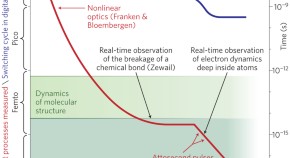Nobel Prize in Physics 2023 (original) (raw)
This Collection is editorially independent, produced with financial support from a third party.About this content.
Highlights
A bright future for attosecond physics
The 2022 Wolf Prize in Physics has been awarded to Paul Corkum, Anne L’Huillier and Ferenc Krausz for their pioneering contributions to ultrafast laser science. Nature Photonics spoke to them about the milestones, challenges and future opportunities for the field.
- Giampaolo Pitruzzello
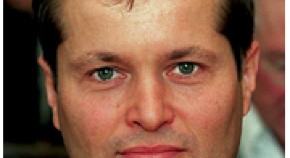
Attosecond analysis
Attosecond spectroscopy promises real-time observation of the motion of electrons inside atoms. Nadya Anscombe talks to Ferenc Krausz from the Max-Planck Institute of Quantum Optics and the Ludwig-Maximilians-University of Munich in Germany about the technology.
- Nadya Anscombe

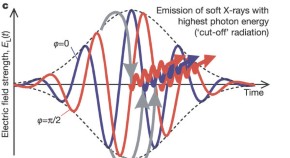
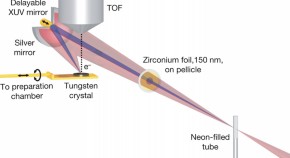
Attosecond spectroscopy in condensed matter
When exposing a tungsten crystal to intense light, the travel times of emitted electrons differ by 110 attoseconds, depending on whether they were originally tightly bound to one atom in the crystal or delocalized over many atoms. This ability to directly probe fundamental aspects of solid-state electron dynamics could aid the further development of modern technologies such as electronics, information processing and photovoltaics.
- A. L. Cavalieri
- N. Müller
- U. Heinzmann
- Article29 Nov 2001 Nature
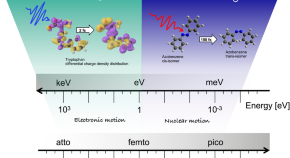
Open questions in attochemistry
Attosecond science is nowadays a well-established research field, and table-top attosecond sources based on high-harmonic generation are routinely used to access electronic motion in matter at its natural time scale. Here, the authors describe a new way of doing chemistry—attochemistry—by directly acting on the electronic motion, and discuss a few key open questions in this emerging field.
- Francesca Calegari
- Fernando Martin
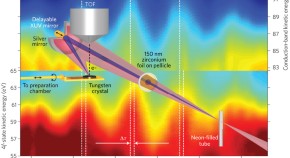
What will it take to observe processes in 'real time'?
Even for simple systems, the interpretations of new attosecond measurements are complicated and provide only a glimpse of their potential. Nonetheless, the lasting impact will be the revelation of how short-time dynamics can determine the electronic properties of more complex systems.
- Stephen R. Leone
- C. William McCurdy
- Marc J. J. Vrakking
The generation and characterization of attosecond pulses of light
Strong-field photoionization revisited
The discovery of an overlooked but apparently ubiquitous spike in the mid-infrared photoelectron spectra of molecular and atomic gases suggests that we don’t know as much as we thought we did about the ionization of matter in strong fields.
- C. I. Blaga
- F. Catoire
- L. F. DiMauro

XFROG phase measurement of threshold harmonics in a Keldysh-scaled system
By exploiting the Keldysh scaling — universal wavelength scaling laws in strong-field physics — direct temporal characterization of high-harmonics is demonstrated using sum-frequency-generation cross-correlation frequency-resolved optical gating (SFG XFROG).
- Erik P. Power
- Anne Marie March
- Louis F. DiMauro
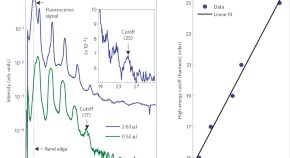
Observation of high-order harmonic generation in a bulk crystal
High-order harmonic generation is a nonlinear optical process that enables the creation of light pulses at frequencies much higher than that from a seed laser. The host medium for this interaction is typically a gas. Now, the process has been observed in a bulk crystalline solid with important implications for attosecond science.
- Shambhu Ghimire
- Anthony D. DiChiara
- David A. Reis
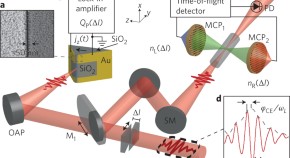
Solid-state light-phase detector
A solid-state device is demonstrated that can detect the absolute offset between the carrier wave and envelope of an ultrashort pulse, the carrier–envelope phase. It holds promise for routine measurement and monitoring of the carrier–envelope phase in attosecond experimental set-ups.
- Tim Paasch-Colberg
- Agustin Schiffrin
- Ferenc Krausz

High-power multi-megahertz source of waveform-stabilized few-cycle light
Frequency combs have revolutionized the study of electronic structures and dynamics of matter but currently used lasers systems are limited in terms of achievable pulse energies. Here, Pronin _et al._demonstrate few cycle pulse emission from a thin-disk laser with 150 nJ pulse energy and 7.7 fs pulse duration.
- O. Pronin
- M. Seidel
- F. Krausz
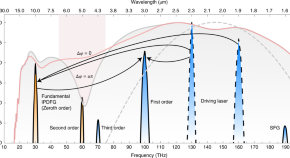
Single-cycle infrared waveform control
Continuously adjustable single-cycle waveform spanning from 0.9 to 12.0 μm is obtained by cascaded intrapulse difference-frequency generation in a ZnGeP2 crystal. The cascade-associated phase response—distinct for different spectral bands—provides a new tuning parameter for waveform adjustment.
- Philipp Steinleitner
- Nathalie Nagl
- Ka Fai Mak
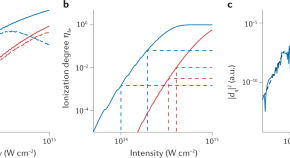
How to optimize high-order harmonic generation in gases
This Expert Recommendation describes how high conversion efficiency in high-order harmonic generation can be achieved over a large range of pressures and medium lengths, following a hyperbolic equation, and provides design guidance for future high-flux extreme ultraviolet sources.
- R. Weissenbilder
- S. Carlström
- A. L’Huillier
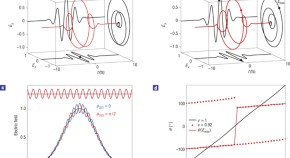
Attosecond angular streaking
A technique that uses the rotating electric-field vector of a circularly polarized laser pulse as a ‘clock’ provides a fresh approach to measuring electron dynamics with attosecond time resolution.
- Petrissa Eckle
- Mathias Smolarski
- Ursula Keller

Spatiotemporal isolation of attosecond soft X-ray pulses in the water window
Time-resolved probing of electronic dynamics such as exciton formation and annihilation requires attosecond pulses at photon energies covering the absorption edges of materials. Here, Silva et al. experimentally demonstrate spatio-temporal isolation of single-attosecond soft X-ray pulses in the water window.
- Francisco Silva
- Stephan M. Teichmann
- Jens Biegert

0.5-keV Soft X-ray attosecond continua
Attosecond soft X-ray pulses hold promise for probing electronic dynamics in real time, but it is challenging to achieve element sensitivity while maintaining temporal resolution. Teichmann et al. report the cover of carbon, nitrogen and oxygen absorption edges with an isolated pulse supporting 13 as duration.
- S. M. Teichmann
- F. Silva
- J. Biegert
The applications of attosecond pulses of light
Attosecond metrology: from electron capture to future signal processing
This article reviews the basic concepts underlying attosecond measurement and control techniques. Emphasis is given to exploring the fundamental speed limit of electronic signal processing that employs ultimate-speed electron metrology provided by attosecond technology.
- Ferenc Krausz
- Mark I. Stockman
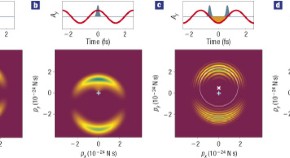
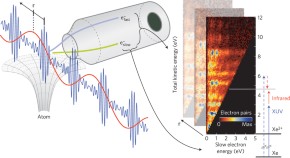
Double ionization probed on the attosecond timescale
To better understand the mechanisms of double ionization following the absorption of one photon, a combination of experimental techniques has been developed to probe the electron emission times in xenon on the attosecond timescale.
- Erik P. Månsson
- Diego Guénot
- Mathieu Gisselbrecht
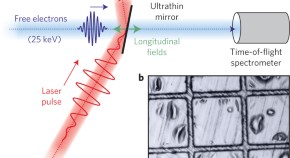
Laser streaking of free electrons at 25 keV
An optical-field-driven streak camera for the temporal characterization (with potentially attosecond resolution) of ultrashort free-electron pulses at 25 keV is demonstrated. It involves intersecting an electron beam and a laser beam at a thin metal mirror.
- F. O. Kirchner
- A. Gliserin
- P. Baum

Attosecond real-time observation of electron tunnelling in atoms
A time-resolved observation of electron tunnelling and the short-lived electronic states that subsequently appear is useful as a new approach to obtain insights in multi-electron dynamics inside atoms and molecules. This technique of 'attosecond tunnelling' is applied to study the cascade of electronic transitions that occur in xenon atoms as a result of their ionization.
- M. Uiberacker
- Th. Uphues
- F. Krausz
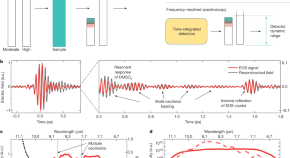
Field-resolved infrared spectroscopy of biological systems
A vibrational spectroscopy technique that measures the electric field emitted from organic molecules following infrared illumination allows their molecular fingerprints to be separated from the excitation background, even in complex biological samples.
- Ioachim Pupeza
- Marinus Huber
- Ferenc Krausz
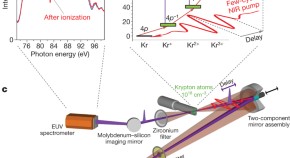
Real-time observation of valence electron motion
Attosecond technology (1 as = 10−18 S) promises the tools needed to directly probe electron motion in real time. These authors report attosecond pump–probe measurements that track the movement of valence electrons in krypton ions. This first proof-of-principle demonstration uses a simple system, but the expectation is that attosecond transient absorption spectroscopy will ultimately also reveal the elementary electron motions that underlie the properties of molecules and solid-state materials.
- Eleftherios Goulielmakis
- Zhi-Heng Loh
- Ferenc Krausz
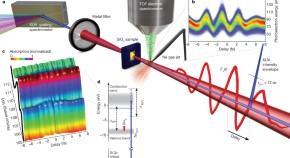
Controlling dielectrics with the electric field of light
The ultrafast reversibility of changes to the electronic structure and electric polarizability of a dielectric with the electric field of a laser pulse, demonstrated here, offers the potential for petahertz-bandwidth optical signal manipulation.
- Martin Schultze
- Elisabeth M. Bothschafter
- Ferenc Krausz
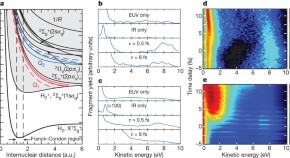
Electron localization following attosecond molecular photoionization
Attosecond (10−18 s) laser pulses make it possible to peer into the inner workings of atoms and molecules on the electronic timescale — phenomena in solids have already been investigated in this way. Here, an attosecond pump–probe experiment is reported that investigates the ionization and dissociation of hydrogen molecules, illustrating that attosecond techniques can also help explore the prompt charge redistribution and charge localization that accompany photoexcitation processes in molecular systems.
- G. Sansone
- F. Kelkensberg
- M. J. J. Vrakking
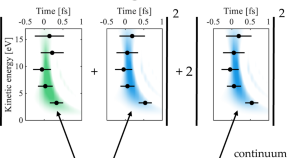
Attosecond dynamics of multi-channel single photon ionization
Understanding of photoionization dynamics, one of the fastest processes in nature, requires the characterization of all underlying ionization channels. Here the authors use an interferometry technique based on attosecond pulses to measure the phase and amplitude of the individual angular momentum channels in the photoionization of neon.
- Jasper Peschel
- David Busto
- Per Eng-Johnsson
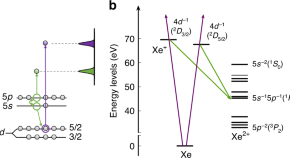
Attosecond electron–spin dynamics in Xe 4d photoionization
Here the authors report experiment and theory study of the photoionization of xenon inner shell 4d electron using attosecond pulses. They have identified two ionization paths - one corresponding to broad giant dipole resonance with short decay time and the other involving spin-flip transitions.
- Shiyang Zhong
- Jimmy Vinbladh
- Anne L’Huillier
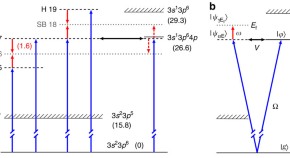
Spectral phase measurement of a Fano resonance using tunable attosecond pulses
Resonant absorption of light in atoms can lead to autoionization, whose probability exhibits a Fano intensity profile. Here, the authors use attosecond pulses and weak infrared radiation to study the phase variation of the photoionization amplitude across an autoionization resonance in argon.
- M. Kotur
- D. Guénot
- A. L’Huillier
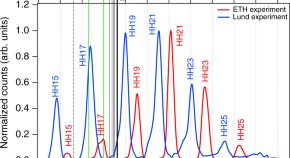
Anisotropic photoemission time delays close to a Fano resonance
Ionization time delays are of interest in understanding the photoionization mechanism in atoms and molecules in ultra-short time scales. Here the authors investigate the angular dependence of photoionization time delays in the presence of an autoionizing resonance in argon atom using RABBITT technique.
- Claudio Cirelli
- Carlos Marante
- Ursula Keller
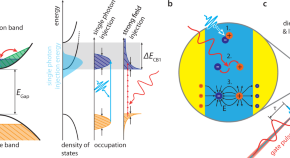
The speed limit of optoelectronics
Though strong-field induced carrier excitation allows for exploring ultrafast electronic properties of a material, characterizing post-excitation dynamics is a challenge. Here, the authors report linear petahertz photoconductive sampling in a solid and use it to real-time probe conduction band electron motion.
- M. Ossiander
- K. Golyari
- M. Schultze
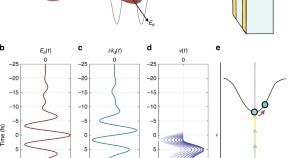
Attosecond optoelectronic field measurement in solids
Characterization of light pulses is important in order to understand their interaction with matter. Here the authors demonstrate a nonlinear photoconductive sampling method to measure electric field wave-forms in the infrared, visible and ultraviolet spectral ranges.
- Shawn Sederberg
- Dmitry Zimin
- Nicholas Karpowicz

Attosecond nanoscale near-field sampling
Photoemission from nanometre-scale structures offer a route toward ultrafast light-field-driven electronic nanocircuits. Here, the authors use attosecond streaking spectroscopy for nanoscale characterization of near-fields in the vicinity of tapered gold nanowires.
- B. Förg
- J. Schötz
- M. F. Kling
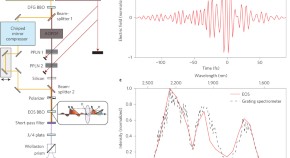
Electro-optic sampling of near-infrared waveforms
Direct measurement of the electric field of light in the near-infrared is experimentally demonstrated, showing that careful optical filtering allows the time-resolved detection of electric field oscillations with half-cycle durations as short as 2.1 fs, even with a 5 fs sampling pulse.
- Sabine Keiber
- Shawn Sederberg
- Nicholas Karpowicz
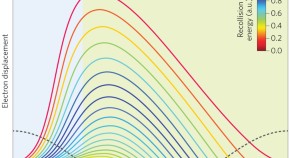
Manipulating quantum paths for novel attosecond measurement methods
Attosecond light pulses are used for ultrahigh-resolution observations of ultrafast phenomena in atoms, molecules and condensed matter. Measuring the durations of such pulses is challenging because the spectrum lies in the vacuum ultraviolet or soft-X-ray range. This article reviews and compares two methods — photoionization and photorecombination — for measuring the duration of attosecond pulses.
- Kyung Taec Kim
- D. M. Villeneuve
- P. B. Corkum

Attosecond molecular dynamics: fact or fiction?
Attosecond science allows the role of electronic coherence in the control of chemical reactions in molecular systems to be investigated. This article reviews recent activities in attosecond molecular science and identifies some promising directions for further development.
- Franck Lépine
- Misha Y. Ivanov
- Marc J. J. Vrakking
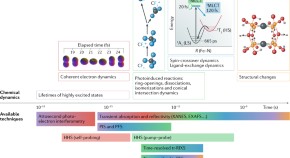
The ultrafast X-ray spectroscopic revolution in chemical dynamics
Ultrafast X-ray spectroscopies enable the investigation of fast chemical dynamics with time resolutions reaching the order of attoseconds. Processes such as spin crossover, structural deformations in excited states and dissociation reactions can now be studied through the use of short X-ray pulses produced by high-harmonic, free-electron-laser and synchrotron sources.
- Peter M. Kraus
- Michael Zürch
- Stephen R. Leone
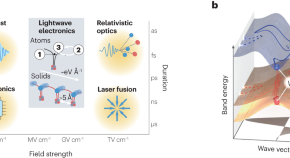
Lightwave electronics in condensed matter
Lightwave electronics could enable the control of interactions in quantum materials and provide access to the quantum phases and quantum information of condensed-matter systems. This Review discusses the fundamental concepts of lightwave electronics and outlines key advances and potential applications.
- Markus Borsch
- Manuel Meierhofer
- Mackillo Kira


